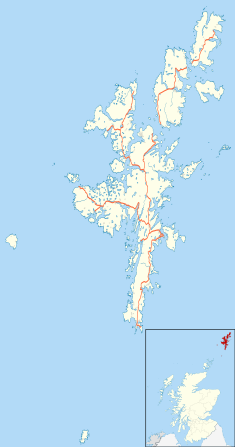| Haltadans | |
|---|---|
| Native name Fairy Ring | |
 A picture of the stone circle | |
| Location | Shetland, Scotland |
| Coordinates | 60°36′36.57″N 0°51′49.95″W / 60.6101583°N 0.8638750°W |
| Built | During the Neolithic Period |
| Architectural style(s) | British pre-Roman Architecture |
Haltadans shown within Shetland | |
Haltadans, also known as Fairy Ring or Haltadans stone circle, is a stone circle on the island of Fetlar in Shetland, Scotland.[1] This site is a ring of 38 stones,[2] of which 22 are still fixed in the soil, and it is 11 metres (37 ft) in diameter.[3] Inside this is an earthen ring 7.9 metres (26 ft) in diameter, with a 1.5 metres (5 ft) gap in the southwest side.[1] In the center of the rings are two rectangular pillars.[1][3]
According to Jakob Jakobsen, the name Haltadans means: "lame or limping dance".[4] This is a reference to the legend that the circle of stones was once a circle of dancing trolls and that the two rock pillars in the centre were once a fiddler and his wife.[3] They had fiddled and danced all night long, and, heedless of the time, were still fiddling and dancing when the sun rose and petrified them all.[2]
See also
[edit] History portal
History portal- Stone circles in the British Isles and Brittany
- List of stone circles
- Neolithic Europe
References
[edit]- ^ a b c "Haltadans". Stone Circle in Scotland in Shetland. Megalithic Portal. Retrieved 12 December 2010.
- ^ a b Smith, Hamish Haswell (16 May 1998). "Fetlar Island of the Week". Scotland Herald. Retrieved 12 December 2010.
- ^ a b c "Fetlar, Gravins, 'Haltadans'". Canmore Site Records. Royal Commission on the Ancient and Historical Monuments of Scotland. Retrieved 12 December 2010.
- ^ Jakobsen, Jakob (1897). The Dialect and Place-Names of Shetland. pp. 116–117.

Well, that’s interesting to know that Psilotum nudum are known as whisk ferns. Psilotum nudum is the commoner species of the two. While the P. flaccidum is a rare species and is found in the tropical islands. Both the species are usually epiphytic in habit and grow upon tree ferns. These species may also be terrestrial and grow in humus or in the crevices of the rocks.
View the detailed Guide of Psilotum nudum: Detailed Study Of Psilotum Nudum (Whisk Fern), Classification, Anatomy, Reproduction